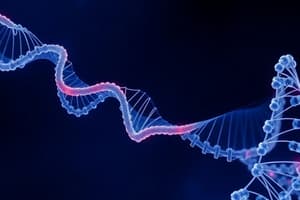Podcast
Questions and Answers
What is a Ramachandran plot used for in biochemistry?
What is a Ramachandran plot used for in biochemistry?
It is used to visualize energetically allowed regions for backbone dihedral angles ψ against φ of amino acid residues in protein structure.
Who developed the Ramachandran plot?
Who developed the Ramachandran plot?
G. N. Ramachandran, C. Ramakrishnan, and V. Sasisekharan
What does the ω angle at the peptide bond indicate?
What does the ω angle at the peptide bond indicate?
It indicates the partial-double-bond character that keeps the peptide bond planar.
How do the edges of the Ramachandran plot 'wrap'?
How do the edges of the Ramachandran plot 'wrap'?
What are the different types of backbone conformational regions shown in the Ramachandran plot?
What are the different types of backbone conformational regions shown in the Ramachandran plot?
What is a Ramachandran plot?
What is a Ramachandran plot?
Who developed the Ramachandran plot?
Who developed the Ramachandran plot?
What does the ω angle at the peptide bond indicate?
What does the ω angle at the peptide bond indicate?
How do the edges of the Ramachandran plot 'wrap'?
How do the edges of the Ramachandran plot 'wrap'?
What are the different types of backbone conformational regions shown in the Ramachandran plot?
What are the different types of backbone conformational regions shown in the Ramachandran plot?
Flashcards
Ramachandran Plot
Ramachandran Plot
Visualizes energetically allowed regions for backbone dihedral angles ψ against φ in protein structures.
Who developed the Ramachandran Plot?
Who developed the Ramachandran Plot?
G. N. Ramachandran, C. Ramakrishnan, and V. Sasisekharan developed it.
ω Angle
ω Angle
Indicates the partial-double-bond character, keeping the peptide bond planar.
Ramachandran Plot Edges
Ramachandran Plot Edges
Signup and view all the flashcards
Backbone Regions
Backbone Regions
Signup and view all the flashcards
Study Notes
Ramachandran Plot
- A Ramachandran plot is a graphical representation of the dihedral angles of a polypeptide chain in a protein, used to visualize and analyze protein structure and conformation.
Development of the Ramachandran Plot
- The Ramachandran plot was developed by G.N. Ramachandran and his colleagues in 1963.
Peptide Bond and ω Angle
- The ω angle at the peptide bond indicates the planarity of the peptide bond, which is typically around 0° or 180°, indicating a planar or nearly planar arrangement.
Plot Edges and Wrapping
- The edges of the Ramachandran plot 'wrap' because the ϕ (phi) and ψ (psi) angles, which represent the dihedral angles of the polypeptide chain, are periodic, with values repeating every 360°.
Backbone Conformational Regions
- The Ramachandran plot shows different types of backbone conformational regions, including:
- α-helix region
- β-sheet region
- Coil region
- Disallowed regions
Studying That Suits You
Use AI to generate personalized quizzes and flashcards to suit your learning preferences.




